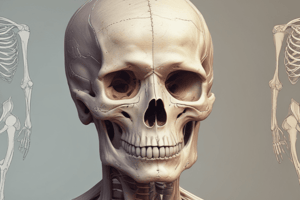Podcast
Questions and Answers
What is the primary function of the vertebral foramina?
What is the primary function of the vertebral foramina?
- To support the head and maintain posture
- To allow for flexibility and shock absorption
- To provide attachment points for muscles
- To house and protect the spinal cord (correct)
Which of the following is NOT a categorization of the vertebral regions?
Which of the following is NOT a categorization of the vertebral regions?
- Cervical
- Scapular (correct)
- Thoracic
- Lumbar
What allows for flexibility and shock absorption in the spinal column?
What allows for flexibility and shock absorption in the spinal column?
- Spinal nerves
- Vertebral bodies
- Ligaments and intervertebral discs (correct)
- Vertebral processes
Which condition directly affects the spinal column?
Which condition directly affects the spinal column?
Which of the following statements is TRUE about the vertebrae?
Which of the following statements is TRUE about the vertebrae?
Which of the following bone types is characterized by a complex shape?
Which of the following bone types is characterized by a complex shape?
What type of muscle tissue controls voluntary movement?
What type of muscle tissue controls voluntary movement?
Which of the following is NOT a function of bones?
Which of the following is NOT a function of bones?
What type of tissue is responsible for the production of blood cells?
What type of tissue is responsible for the production of blood cells?
What is the name of the shaft of a long bone?
What is the name of the shaft of a long bone?
Which of the following organs is NOT part of the digestive system?
Which of the following organs is NOT part of the digestive system?
Which of the following statements about organs is TRUE?
Which of the following statements about organs is TRUE?
What is the term used to describe the arrangement and spatial relationships of organs within the body cavity?
What is the term used to describe the arrangement and spatial relationships of organs within the body cavity?
Flashcards
Muscle Atrophy
Muscle Atrophy
The decrease in muscle mass due to lack of use or injury.
Vertebrae
Vertebrae
The individual bones that make up the spinal column, protecting the spinal cord.
Intervertebral Discs
Intervertebral Discs
Cartilaginous structures that sit between vertebrae, allowing flexibility and shock absorption.
Cervical Region
Cervical Region
Signup and view all the flashcards
Herniated Disc
Herniated Disc
Signup and view all the flashcards
Function of Bones
Function of Bones
Signup and view all the flashcards
Types of Bone Tissue
Types of Bone Tissue
Signup and view all the flashcards
Long Bones Structure
Long Bones Structure
Signup and view all the flashcards
Types of Muscles
Types of Muscles
Signup and view all the flashcards
Muscle Contraction Mechanism
Muscle Contraction Mechanism
Signup and view all the flashcards
Bone Growth Process
Bone Growth Process
Signup and view all the flashcards
Role of Bone Marrow
Role of Bone Marrow
Signup and view all the flashcards
Gross Anatomy
Gross Anatomy
Signup and view all the flashcards
Study Notes
Bones
- Bones provide support and structure to the body.
- They protect vital organs, such as the brain, heart, and lungs.
- Bone tissue is a major storage site for calcium and phosphorus.
- Bones are made up of several different types of tissue, including compact bone (dense outer layer) and spongy bone (porous inner layer).
- Long bones, such as the femur, have a shaft (diaphysis) and two ends (epiphysis).
- Short bones, such as the carpals and tarsals, are roughly cube-shaped.
- Flat bones, such as the ribs and skull bones, are thin and flat.
- Irregular bones, such as the vertebrae, have complex shapes.
- Bones are connected to each other at joints, which allow for movement.
- Bone growth and remodeling are ongoing processes throughout life.
- Bone marrow, found within the spongy bone, produces blood cells.
- Common bone disorders include osteoporosis, fractures, and arthritis.
- Different types of bone structures include sutural bones, sesamoid bones, and wormian bones.
Organs
- Organs are groups of tissues that work together to perform specific functions.
- Examples of major organ systems include the digestive, respiratory, cardiovascular, nervous, and endocrine systems.
- Each organ system contains various organs that carry out coordinated tasks needed for bodily functions.
- Organs frequently work in conjunction to maintain homeostasis.
- Examples of specific organs include the heart, lungs, stomach, liver, kidneys, brain, and intestines.
- The placement and position of organs is essential for efficient operation.
- The spatial relationships of organs in the body cavity are referred to as gross anatomy.
- Organ structures and functionality are influenced by surrounding muscles and other tissues.
Muscles
- Muscles are responsible for movement and maintaining posture.
- They are composed of specialized cells called muscle fibers.
- Muscles are classified into three types: skeletal (voluntary), smooth (involuntary), and cardiac (involuntary).
- Skeletal muscles are attached to bones by tendons and are responsible for voluntary movements.
- Smooth muscles are found in the walls of internal organs and are responsible for involuntary movements.
- Cardiac muscle is found only in the heart and is responsible for pumping blood throughout the body.
- Muscle contraction involves the sliding of actin and myosin filaments within the muscle fibers.
- Muscle tissue requires energy to contract and relax.
- Muscle atrophy, hypertrophy, and strains are common conditions associated with muscles.
- Contractile tissues, such as muscle tissue, are fundamental to movement throughout the body.
Vertebrae
- Vertebrae are the individual bones that form the spinal column.
- They are irregular bones that provide structural support to the body.
- The spinal column houses and protects the spinal cord.
- Vertebrae are categorized into cervical, thoracic, lumbar, sacral, and coccygeal regions.
- Each vertebral region has distinct characteristics in terms of size, shape, and processes.
- Vertebral regions exhibit different curvatures and sizes depending on their locations in the spine.
- The vertebrae are interconnected by ligaments and intervertebral discs, which allow for flexibility and shock absorption.
- The spinal column supports the head, maintains posture, and allows for movement.
- Problems like herniated discs and scoliosis can affect the spinal column.
- Vertebral foramina provide a tunnel for the spinal cord to pass through the vertebrae.
Studying That Suits You
Use AI to generate personalized quizzes and flashcards to suit your learning preferences.





